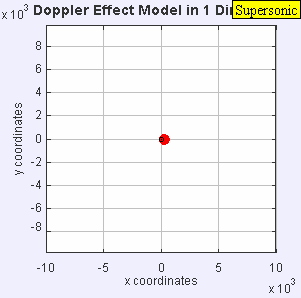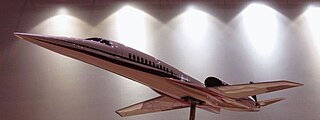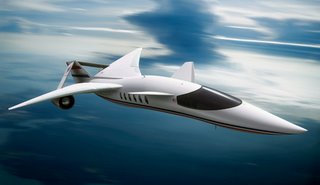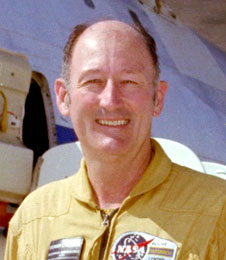
The Boeing 2707 was an American supersonic passenger airliner project during the 1960s. After winning a competition for a government-funded contract to build an American supersonic airliner, Boeing began development at its facilities in Seattle, Washington. The design emerged as a large aircraft with seating for 250 to 300 passengers and cruise speeds of approximately Mach 3. It was intended to be much larger and faster than competing supersonic transport (SST) designs such as Concorde.

A sonic boom is a sound associated with shock waves created when an object travels through the air faster than the speed of sound. Sonic booms generate enormous amounts of sound energy, sounding similar to an explosion or a thunderclap to the human ear.

A supersonic transport (SST) or a supersonic airliner is a civilian supersonic aircraft designed to transport passengers at speeds greater than the speed of sound. To date, the only SSTs to see regular service have been Concorde and the Tupolev Tu-144. The last passenger flight of the Tu-144 was in June 1978 and it was last flown in 1999 by NASA. Concorde's last commercial flight was in October 2003, with a November 26, 2003 ferry flight being its last airborne operation. Following the permanent cessation of flying by Concorde, there are no remaining SSTs in commercial service. Several companies have each proposed a supersonic business jet, which may bring supersonic transport back again.

The NASA Neil A. Armstrong Flight Research Center (AFRC) is an aeronautical research center operated by NASA. Its primary campus is located inside Edwards Air Force Base in California and is considered NASA's premier site for aeronautical research. AFRC operates some of the most advanced aircraft in the world and is known for many aviation firsts, including supporting the first crewed airplane to exceed the speed of sound in level flight, highest speed by a crewed, powered aircraft, the first pure digital fly-by-wire aircraft, and many others. AFRC operates a second site next to Air Force Plant 42 in Palmdale, California, known as Building 703, once the former Rockwell International/North American Aviation production facility. There, AFRC houses and operates several of NASA's Science Mission Directorate aircraft including SOFIA, a DC-8 Flying Laboratory, a Gulfstream C-20A UAVSAR and ER-2 High Altitude Platform. As of 2023, Bradley Flick is the center's director.
Gulfstream Aerospace Corporation is an American aircraft company and a wholly owned subsidiary of General Dynamics. Gulfstream designs, develops, manufactures, markets, and services business jet aircraft. Gulfstream has produced more than 2,000 aircraft since 1958. Gulfstream's current range consists of the G280, G550, G500/G600, and G650/G650ER/G700/G800.

The NASA X-43 was an experimental unmanned hypersonic aircraft with multiple planned scale variations meant to test various aspects of hypersonic flight. It was part of the X-plane series and specifically of NASA's Hyper-X program developed in the late 1990s. It set several airspeed records for jet aircraft. The X-43 is the fastest jet-powered aircraft on record at approximately Mach 9.6.

The NASA Shaped Sonic Boom Demonstration, also known as the Shaped Sonic Boom Experiment, was a two-year program that used a Northrop F-5E with a modified fuselage to demonstrate that the aircraft's shock wave, and accompanying sonic boom, can be shaped, and thereby reduced. The program was a joint effort between NASA's Langley Research Center, Dryden Flight Research Center at Edwards Air Force Base, California and Northrop Grumman.

A supersonic aircraft is an aircraft capable of supersonic flight, that is, flying faster than the speed of sound. Supersonic aircraft were developed in the second half of the twentieth century. Supersonic aircraft have been used for research and military purposes, but only two supersonic aircraft, the Tupolev Tu-144 and the Concorde, ever entered service for civil use as airliners. Fighter jets are the most common example of supersonic aircraft.
The Aerion SBJ was a supersonic business jet project designed by American firm Aerion Corporation. Unveiled in 2004, the designer sought a joint venture with a business aircraft manufacturer for a $1.2–1.4 billion development in 7–8 years. Aerion received 50 letters-of-intent before enlarging the design as the Aerion AS2 in 2014. Powered by two Pratt & Whitney JT8D-219 engines, the $80 million aircraft was to transport 8–12 passengers up to Mach 1.6 and up to 4,000 nmi (7,400 km).

A supersonic business jet (SSBJ) is a business jet travelling above the speed of sound: a supersonic aircraft. Some manufacturers are designing or have been designing SSBJs, but none are currently available. Usually intended to transport about ten passengers, proposed SSBJs would be about the same size as subsonic business jets.

The SAI Quiet Supersonic Transport (QSST) was a project by Supersonic Aerospace International (SAI) to develop a "virtually boomless" commercial supersonic business jet. The project was announced around the year 2000 and provided update announcements until 2010. After three years without any updates, the last update was in 2013. As of 2023, there have been no more updates, and the project appears to have been abandoned.

Fitzhugh L. "Fitz" Fulton, Jr., , was a civilian research pilot at NASA's Dryden Flight Research Center, Edwards, California, from August 1, 1966, until July 3, 1986, following 23 years of distinguished service as a pilot in the U.S. Air Force.

Quiet Spike was a collaborative program between Gulfstream Aerospace and NASA's Dryden Flight Research Center to investigate the suppression of sonic booms. The patent was published with the United States Patent and Trademark Office in 2004 and is owned by Gulfstream Aerospace.

The High Speed Civil Transport (HSCT) was the focus of the NASA High-Speed Research (HSR) program, which intended to develop the technology needed to design and build a supersonic transport that would be environmentally acceptable and economically feasible. The aircraft was to be a future supersonic passenger aircraft, baselined to cruise at Mach 2.4, or more than twice the speed of sound. The project started in 1990 and ended in 1999.

The Spike S-512 is a projected supersonic business jet, designed by Spike Aerospace, an American aerospace manufacturer firm based in Boston, Massachusetts.

The Aerion AS2 was a proposed supersonic business jet that was being developed by Aerion Corporation. In May 2014, it was announced that the Aerion AS2 would be part of a larger Aerion SBJ redesign, which aimed for release after a seven-year developmental period. Aerion partnered with Airbus in September the same year. In December 2017, Airbus was replaced by Lockheed Martin. Its General Electric Affinity engine was unveiled in October 2018. In February 2019, Boeing replaced Lockheed Martin. Development stopped when Aerion ceased operations in May 2021.

The Lockheed Martin X-59 QuessT is an American experimental supersonic aircraft being developed at Skunk Works for NASA's Low-Boom Flight Demonstrator project. Preliminary design started in February 2016, with the X-59 to be delivered to NASA in 2021 for flight testing in 2023. It is expected to cruise at Mach 1.42 at an altitude of 55,000 ft (16,800 m), creating a low 75 Perceived Level decibel (PLdB) thump to evaluate supersonic transport acceptability.

The Boom Overture is a proposed Mach 1.7, 64–80 passenger supersonic airliner with 4,250 nmi of range, which is planned to be introduced in 2029 by Boom Technology. The company claims that with 500 viable routes, there could be a market for 1,000 supersonic airliners with business class fares. It had gathered 76 commitments by December 2017. The aircraft is planned to have a delta wing configuration, but will be built with composite materials. Following a redesign revealed in 2022 it is intended to be powered by four dry (non-afterburning) 35,000 lbf (160 kN) turbofans. Regulations for takeoff noise or overland boom can be met or changed.















